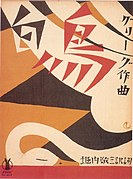Takehisa Yumeji
Takehisa Yumeji ( Japanese 竹 久 夢 二 ; born January 16, 1884 ; died September 1, 1934 ) was a Japanese painter and poet.
Life
Yumeji was born as Shigejirō Takehisa in Okayama Prefecture , the son of a sake trader in Oku (now the Okuchō district of Setouchi) . During his studies from 1902 at the technical school Tōkyō (forerunner of Waseda University ) his drawings were published in the newspaper Yomiuri Shimbun u. a. Pages printed. From 1905 he was able to make drawings for printed products for the Heiminsha publishing house on a regular basis through a friend's mediation. From this time on he used the first name Yumeji. He led a bohemian life, developing closer ties with some of his models.
In May 1931, Yumeji traveled to California where he had exhibitions and lectured. From there, in September 1932, he traveled on board the German cargo ship Takoma through the Panama Canal to Hamburg, stayed for two months in Berlin and visited various European countries, always drawing diligently. After returning to Japan in late 1933, he fell ill with tuberculosis and died the following year. His grave is in the Zōshigaya Cemetery , Tokyo.
Style and effect
Yumeji became famous with his pictures that reflect the feeling of Taishō democracy , Taishō romance. In addition to the young girls in kimono, the moga ( modern girl ) is also portrayed in a western fashion: self-confident, but also vulnerable. The influence of Art Deco , which found its way into Japan at the time, can also be felt in Yumeji. The majority of his works are graphics, water-color drawings, gouaches , but there are also oil paintings of him. As an autodidact outside the established art market, he made a living from illustrations, book and music book cover designs as well as from design and the like. a. some of his watercolors also appeared as prints, although the subtleties of the original were lost. For the major music publisher Sen-On, he designed numerous covers for song sheet music.
From his poetic work, his three- verse poem Yoimachigusa is particularly unforgettable. This is actually the name of a flower that can be translated as "waiting for the good, what is desired".
He was forgotten after his death, but was rediscovered in the 1960s. The Post dedicated a stamp with the well-known picture "Kurofuneya" to him. Today museums compete with each other in different places. E.g. in the city of Okayama the Yumeiji Art Museum ( 夢 二 郷 土 美術館 , Yumeji kyōdo bijutsukan ), in Tokyo the Yumeji Takehisa Museum ( 夢 二 美術館 , Yumeji Bijutsukan ), in the Ikaho das ( uchten 二 美術館 , Yumeji Bijutsukan ) visited by Yumeji and famous for its hot springs ( 竹 久 夢 二 伊 香 保 記念 館 , Takehisa Yumeji Ikaho kinenkan).
photos
Cover for a song by Schumann
Cover for "The Swan" by Grieg
"Yoimachigusa" memorial stone in Kōrakuen Park, Okayama
Remarks
- ↑ so-called koma-e, small-format drawings for newspapers and magazines.
- ↑ as タ コ マ in Japanese literature.
- ↑ There he also gave lessons in Japanese painting at the Johannes Itten painting school .
literature
- Takehisa Yumeji Ikaho kinenkan (ed.): Taishō no neiro - Taishō no akashi - Kagirinaki Yumeji no sekai. no year
- Kawano, et al. a. (Ed): Yumeji. Machida shiritsu kokusai hanga bijutsukan (2001)
- Yumeji kyōdo bijutsukan (Ed): Yumeji kyōdo bijutsukan I (1997)
- Yumeji kyōdo bijutsukan (Ed): Yumeji kyōdo bijutsukan II (1996)
- Aoki, M. (Ed.): Yumeji Yōroppa sobyōjō. Tōkyō kopii publishing house (1996), ISBN 4-490-20296-2
- Asahi shimbun: Bijutsu tokushū Nihonhe 58 - Takehisa Yumeji (1988)
- Daiichi hōki: Nihon Suisaiga meisaku zenshū 3 - Takehisa Yumeji (1982)
Web links
| personal data | |
|---|---|
| SURNAME | Takehisa, Yumeji |
| ALTERNATIVE NAMES | 竹 久 夢 二 (Japanese); Takehisa, Shigejirō (real name); 竹 久 茂 次郎 (real name, Japanese) |
| BRIEF DESCRIPTION | Japanese painter |
| DATE OF BIRTH | January 16, 1884 |
| DATE OF DEATH | September 1, 1934 |






